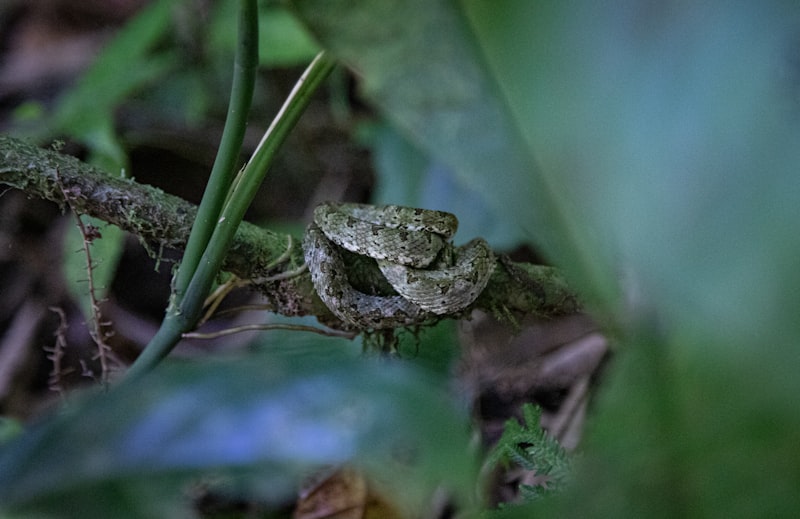One of the most fascinating adaptations is camouflage, where animals blend seamlessly into their surroundings to avoid predators or ambush prey. Take the snowshoe hare, for instance, whose fur changes color from brown in summer to white in winter, allowing it to hide effectively in both seasons. This adaptation not only aids in protection but also enhances hunting success.
Another remarkable adaptation is the ability of certain animals to hibernate. Bears, for example, stock up on food and then enter a state of dormancy during the winter months when food is scarce. By lowering their metabolic rate and living off stored fat, they conserve energy until spring returns.
In contrast, some desert dwellers, like the fennec fox, have evolved to withstand extreme heat. Their large ears dissipate heat and help regulate body temperature, allowing them to thrive in the blistering desert environment. This adaptation showcases nature’s ingenuity in coping with harsh climates.
Animals also exhibit behavioral adaptations. Migration, for instance, is a widespread strategy among birds such as the Arctic tern, which travels over 40,000 miles annually between its breeding grounds in the Arctic and its wintering grounds in Antarctica. This migration ensures access to abundant food sources and suitable breeding habitats throughout the year.
Moreover, the unique feeding habits of certain animals illustrate adaptation in action. The giraffe, with its long neck and specialized tongue, feeds on leaves high in the treetops where competition for food is lower. This adaptation allows giraffes to access a niche food source that other herbivores cannot reach.
Understanding these adaptations provides a glimpse into the complex and interconnected web of life on Earth. Each adaptation represents millions of years of evolutionary refinement, showcasing nature’s resilience and creativity in the face of diverse challenges.
Survival Tactics: Exploring the Fascinating World of Animal Adaptations
Ever wondered how animals manage to thrive in the wild, facing diverse environments and challenges? It’s all about survival tactics and incredible adaptations. From the deserts of Africa to the icy waters of Antarctica, each species has evolved unique strategies to endure and prosper.
Let’s dive into the intriguing realm of animal adaptations. Picture a camel effortlessly traversing the scorching sands of the Sahara. Its hump isn’t just a quirky feature but a masterpiece of adaptation. It stores fat reserves, providing energy and hydration when water sources are scarce. This remarkable ability allows camels to endure weeks without drinking water, surviving in one of Earth’s most arid environments.

Now, shift your gaze to the mighty polar bear, ruler of the Arctic. Its thick, insulating fur isn’t just for warmth but also serves as camouflage among snow-covered landscapes. Those massive paws? They act like snowshoes, preventing the bear from sinking into the soft snow while hunting seals. These adaptations aren’t just about surviving; they ensure the polar bear thrives in one of the harshest climates on the planet.
On the other end of the spectrum, consider the incredible eyesight of the eagle. With vision up to eight times sharper than humans, these birds of prey spot small rodents from incredible heights, swooping down with pinpoint accuracy. Their sharp talons and hooked beaks are formidable tools honed over millennia, perfectly adapted for hunting and survival in diverse habitats.
Animals like the chameleon take adaptation to another level with their color-changing abilities. Imagine blending seamlessly into your surroundings as easily as changing a shirt. This not only helps them evade predators but also allows them to sneak up on unsuspecting prey.
Nature’s ingenuity doesn’t stop there. From the echolocation of bats to the bioluminescence of deep-sea creatures, every adaptation tells a story of evolution and survival. Each trait has been finely tuned through the ages, ensuring species not only endure but flourish in their environments.
Understanding these adaptations not only enriches our knowledge of the natural world but also underscores the importance of biodiversity and conservation. As we uncover more about how animals adapt, we gain insights that may inspire technological innovations or conservation strategies to protect these incredible species.
Nature’s playbook is vast and endlessly fascinating. The next time you observe an animal in its habitat, consider the remarkable adaptations that enable its survival. It’s a testament to the power of evolution and the resilience of life on Earth.
Nature’s Marvels: How Animals Adapt to Thrive in Extreme Environments
Animals across the globe exhibit incredible adaptations that allow them to not just survive but thrive in some of the harshest environments on Earth. From scorching deserts to icy tundras, each species has evolved unique strategies to conquer their surroundings.
In the blistering heat of deserts like the Sahara, where temperatures soar and water is scarce, creatures like the fennec fox have adapted remarkably. Sporting oversized ears that help dissipate heat, these foxes minimize water loss and are primarily nocturnal to avoid the searing daytime sun. Their light-colored fur reflects sunlight, further aiding in temperature regulation.
Conversely, in the freezing expanses of the Arctic, animals like the Arctic fox have evolved thick fur coats that provide insulation against the cold. Their rounded bodies and short limbs minimize heat loss, while their keen sense of smell helps them locate prey beneath thick layers of snow. These foxes change their fur color seasonally, blending into their snowy surroundings to evade predators and sneak up on prey.
In the depths of the ocean, where sunlight doesn’t penetrate and pressure is immense, creatures like the anglerfish have developed bioluminescent lures to attract prey in the darkness. These deep-sea marvels use their unique adaptations to thrive in an environment where food is scarce and survival demands ingenuity.
Evolutionary Wonders: Unraveling the Secrets Behind Animal Adaptations
Take the remarkable case of the giraffe, whose towering neck isn’t just for reaching high leaves. It’s a testament to adaptation over millennia, allowing them to feed on foliage beyond the reach of other herbivores. This adaptation not only aids in nourishment but also serves as a defense mechanism against predators, offering a vantage point to detect threats from afar.
In contrast, the Arctic fox flaunts its winter wardrobe—a plush, thick fur coat that transforms from brown to snowy white with the seasons. This adaptation is crucial for survival in its frigid habitat, providing insulation against extreme cold and doubling as camouflage against snow-covered landscapes, enabling stealthy hunting and evading predators.
Meanwhile, the remarkable mimicry skills of the orchid mantis are a marvel of deception in the insect world. Resembling a flower petal with uncanny accuracy, this mantis lures unsuspecting pollinators directly into its grasp. Such adaptation not only secures its next meal but also ensures its survival by avoiding detection from predators.
These examples underscore the essence of animal adaptations—a dynamic interplay between genetic traits and environmental challenges. Through natural selection, species evolve characteristics that optimize their chances of survival and reproduction in their specific habitats. Whether it’s the strength of a beetle’s exoskeleton or the agility of a cheetah’s sprint, every adaptation tells a tale of resilience and evolutionary success.
As we unravel the secrets behind these evolutionary wonders, we gain a deeper appreciation for the diversity of life on Earth and the intricate mechanisms that drive it. Each adaptation is a masterpiece of nature’s craftsmanship, honed through eons of trial and adaptation, ensuring that animals thrive in their respective niches.
From Arctic to Desert: A Deep Dive into Diverse Animal Adaptations

From the icy expanses of the Arctic to the scorching sands of the desert, animals have evolved remarkable adaptations to thrive in diverse environments. Imagine a polar bear, its thick fur and layer of blubber protecting it from freezing temperatures, contrasting with a desert camel, equipped with long eyelashes and specialized kidneys to conserve water in arid climates. These adaptations aren’t just survival mechanisms; they’re nature’s ultimate solutions to extreme challenges.
In the Arctic, where temperatures plummet, animals like the Arctic fox boast dense fur that turns white in winter for camouflage, blending seamlessly with the snowy landscape. This transformation not only aids in hunting but also offers protection from predators. Meanwhile, in the blistering heat of deserts, creatures like the fennec fox have oversized ears that dissipate heat, acting as natural air conditioners. Their ability to thrive in the relentless sun is a testament to nature’s ingenuity.
Consider the saguaro cactus wren, a bird that makes its home in the prickly arms of cacti, safe from ground predators and shielded from the desert’s sweltering sun. Its nest provides insulation against temperature extremes, showcasing how animals adapt to utilize their environment to the fullest.
These adaptations go beyond physical features; they include behavioral strategies too. From migrating thousands of miles to find food to burrowing deep underground to escape heat, each animal has honed skills that ensure its survival in its specific habitat.
Nature’s diversity is not just a spectacle but a profound example of resilience and adaptation. As we explore these unique creatures, we gain a deeper appreciation for the intricacies of life on Earth. How did these adaptations come to be? What can they teach us about resilience and survival? These questions invite us to marvel at the wonders of evolution and the incredible ways in which animals have shaped their destinies in environments as challenging as they are diverse.
This article aims to capture the fascination and wonder of animal adaptations while maintaining a conversational tone and engaging the reader with rhetorical questions and vivid descriptions.
Camouflage Masters: How Animals Use Color and Shape to Blend In
These “Camouflage Masters” utilize a combination of color patterns and body shapes to evade detection. Take the leaf-tailed gecko of Madagascar, for instance, with its body shaped like a dead leaf complete with veins and discolorations. This uncanny resemblance to foliage helps it vanish into the forest undergrowth, escaping the eyes of predators such as birds and snakes.
Similarly, the snowshoe hare of North America changes its fur from brown in summer to white in winter, perfectly matching the snow-covered landscape. This adaptation not only provides camouflage but also helps regulate body temperature and avoid predators like lynxes and owls.
In the depths of the ocean, creatures like the cuttlefish use dynamic camouflage, altering their skin texture and color to match the coral reefs or sandy seabeds they inhabit. This rapid change allows them to ambush prey or hide from larger predators lurking nearby.
Camouflage isn’t just about blending in; it’s also about survival of the fittest. Animals that master camouflage techniques have a higher chance of passing on their genes to the next generation, ensuring their species’ continued existence in diverse habitats around the world.
From deserts to forests and oceans, nature’s camouflage masters teach us about adaptation, evolution, and the art of staying hidden in plain sight. Their ability to merge seamlessly with their environment challenges our perceptions and highlights the incredible diversity of strategies animals employ to thrive in the wild.
Adapt or Perish: The Critical Role of Adaptations in Animal Species
Consider the Arctic fox, perfectly suited to its frigid environment. Its thick fur coat provides insulation against freezing temperatures, while its small, compact body conserves heat. These adaptations allow it to thrive where others would perish, showcasing nature’s ingenious solutions to extreme conditions.
For animals like the giraffe, evolution has stretched their necks to reach the tender leaves atop tall trees. This adaptation isn’t just about convenience but survival. By accessing food sources others can’t, giraffes ensure their sustenance even in times of scarcity.
Even behaviors can be adaptive. The migration of wildebeests across the Serengeti isn’t just a spectacle; it’s a survival strategy. By following the rains and fresh grass, these animals ensure they always have food, avoiding areas where resources are scarce or predators lurk.
Adaptations aren’t always physical. The social structure of bees, with their intricate hierarchy and cooperative behavior, ensures the survival of the colony. Each bee knows its role, from queen to worker, contributing to the greater good of the hive’s survival.
Frequently Asked Questions
How do animals adapt to their environments?
Animals adapt to their environments through evolutionary processes that enhance survival and reproduction. They develop physical features, behaviors, and physiological traits suited to their surroundings, ensuring better chances of thriving and passing on their genes.
How can humans learn from animal adaptations to improve technology and sustainability?
Discover how human technology and sustainability practices can benefit from studying animal adaptations. Explore how observing nature’s solutions can inspire innovations in engineering, architecture, and environmental conservation. Learn about biomimicry and its potential to create more efficient, eco-friendly designs.
What are some examples of animal adaptations in different habitats?
Discover examples of animal adaptations across various habitats, showcasing how species modify behaviors, body structures, and physiological processes to thrive in their environments. From camouflaging skin tones in deserts to streamlined bodies for underwater agility, explore how animals adapt to survive and thrive in diverse ecosystems.
How do animal adaptations help species survive and thrive?
Discover how animal adaptations enable species to survive and thrive in their environments. Learn about the unique traits and behaviors that help animals secure food, evade predators, and withstand varying climates.
What are animal adaptations and why are they important?
Learn about animal adaptations and their significance in survival and evolution. Discover how these unique traits help animals thrive in their environments, from camouflage to specialized feeding mechanisms.


